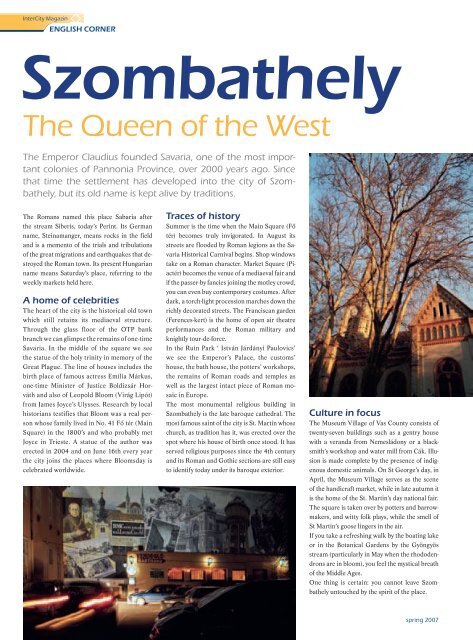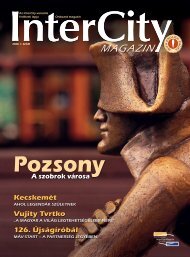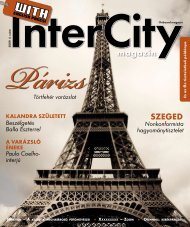You also want an ePaper? Increase the reach of your titles
YUMPU automatically turns print PDFs into web optimized ePapers that Google loves.
InterCity Magazin<br />
ENGLISH CORNER<br />
<strong>Szombathely</strong><br />
the Queen of the West<br />
the emperor Claudius founded savaria, one of the most important<br />
colonies of Pannonia Province, over 2000 years ago. since<br />
that time the settlement has developed into the city of szombathely,<br />
but its old name is kept alive by traditions.<br />
The Romans named this place Sabaria after<br />
the stream Siberis, today’s Perint. Its German<br />
name, Steinamanger, means rocks in the field<br />
and is a memento of the trials and tribulations<br />
of the great migrations and earthquakes that destroyed<br />
the Roman town. Its present Hungarian<br />
name means Saturday’s place, referring to the<br />
weekly markets held here.<br />
A home of celebrities<br />
The heart of the city is the historical old town<br />
which still retains its mediaeval structure.<br />
Through the glass floor of the OTP bank<br />
branch we can glimpse the remains of one-time<br />
Savaria. In the middle of the square we see<br />
the statue of the holy trinity in memory of the<br />
Great Plague. The line of houses includes the<br />
birth place of famous actress Emília Márkus,<br />
one-time Minister of Justice Boldizsár Horváth<br />
and also of Leopold Bloom (Virág Lipót)<br />
from James Joyce’s Ulysses. Research by local<br />
historians testifies that Bloom was a real person<br />
whose family lived in No. 41 Fő tér (Main<br />
Square) in the 1800’s and who probably met<br />
Joyce in Trieste. A statue of the author was<br />
erected in 2004 and on June 16th every year<br />
the city joins the places where Bloomsday is<br />
celebrated worldwide.<br />
Traces of history<br />
Summer is the time when the Main Square (Fő<br />
tér) becomes truly invigorated. In August its<br />
streets are flooded by Roman legions as the Savaria<br />
Historical Carnival begins. Shop windows<br />
take on a Roman character. Market Square (Piactér)<br />
becomes the venue of a mediaeval fair and<br />
if the passer-by fancies joining the motley crowd,<br />
you can even buy contemporary costumes. After<br />
dark, a torch-light procession marches down the<br />
richly decorated streets. The Franciscan garden<br />
(Ferences-kert) is the home of open air theatre<br />
performances and the Roman military and<br />
knightly tour-de-force.<br />
In the Ruin Park ‘ István Járdányi Paulovics’<br />
we see the Emperor’s Palace, the customs’<br />
house, the bath house, the potters’ workshops,<br />
the remains of Roman roads and temples as<br />
well as the largest intact piece of Roman mosaic<br />
in Europe.<br />
The most monumental religious building in<br />
<strong>Szombathely</strong> is the late baroque cathedral. The<br />
most famous saint of the city is St. Martin whose<br />
church, as tradition has it, was erected over the<br />
spot where his house of birth once stood. It has<br />
served religious purposes since the 4th century<br />
and its Roman and Gothic sections are still easy<br />
to identify today under its baroque exterior.<br />
Culture in focus<br />
The Museum Village of Vas County consists of<br />
twenty-seven buildings such as a gentry house<br />
with a veranda from Nemesládony or a blacksmith’s<br />
workshop and water mill from Cák. Illusion<br />
is made complete by the presence of indigenous<br />
domestic animals. On St George’s day, in<br />
April, the Museum Village serves as the scene<br />
of the handicraft market, while in late autumn it<br />
is the home of the St. Martin’s day national fair.<br />
The square is taken over by potters and barrowmakers,<br />
and witty folk plays, while the smell of<br />
St Martin’s goose lingers in the air.<br />
If you take a refreshing walk by the boating lake<br />
or in the Botanical Gardens by the Gyöngyös<br />
stream (particularly in May when the rhododendrons<br />
are in bloom), you feel the mystical breath<br />
of the Middle Ages.<br />
One thing is certain: you cannot leave <strong>Szombathely</strong><br />
untouched by the spirit of the place.<br />
Where life is a joy<br />
the thousand faces of France<br />
the Franks were certainly justified in fighting for their country<br />
through a history of wars and hostilities: this piece of land, six<br />
times the size of Hungary and the home of 58 million people, is<br />
more than beautiful.<br />
The banks of the Seine<br />
A tour of Paris must include a walk along the<br />
Champs Élysées, as well as a rest in at least<br />
two cafés. ‘Un café au lait!’ you say and in a<br />
wink you have a lovely cup of milky coffee.<br />
‘Merci beaucoup!’ is another vital phrase. It<br />
is time to start learning the shop signs. In a<br />
boulangerie you can buy a baguette or a few<br />
croissants and a bottle of fizzy drink and you<br />
are fitted out for a long tour of the city. Walking<br />
along the Champs Élysées you cannot miss<br />
the Eiffel Tower on Champ de Mars, open to<br />
visitors till late at night. Reach the first and<br />
second floor by lift or stairs, but the top can<br />
only be accessed by a rapid elevator. This<br />
costs over ten Euros, but the price is worth<br />
paying for the view you get from a height of<br />
306 meters.<br />
The magic buzz<br />
Not far from the tower lies the famous Quartier<br />
Latin which you can reach by metro. Public<br />
transport is a treat. The metro runs very<br />
frequently, some trains rolling along on rubber<br />
tyres, and some of the stops located on<br />
a bend. Traffic along the fourteen different<br />
lines is tuned in with the suburban railway.<br />
There is no need to study the maps: your tourist<br />
ticket covers three zones and allows you to<br />
visit most of the famous sights. Quartier Latin<br />
is supposed to be the students’ quarter, but<br />
you find more tourists in the streets. You can<br />
stroll over to the little island of Nôtre Dame,<br />
surrounded by no less than ten bridges. Get<br />
back on the metro and pop over to Montmartre:<br />
this ‘artists’ quarter’ is a jungle of vibrant<br />
little streets with a bohemian air. Almost each<br />
house was once the home of some celebrity.<br />
In these cafés Picasso, Renoir, Van Gogh used<br />
to hold their lively discussions. In spring the<br />
streets are populated by painters and artists<br />
who will draw your portrait any time, just like<br />
those outside the Pompidou Centre. You must<br />
not miss Sacré Coeur, the cathedral which<br />
stands on top of a low hill and offers a lovely<br />
view from its dome.<br />
People say, if it is Paris, it is the Louvre. This<br />
is the oldest museum in the world, where<br />
you can admire works from Egyptian times,<br />
masterpieces of Islam or the miracles of the<br />
Italian masters. Before you enter, it is worth<br />
deciding which sections, collections, floor or<br />
epoch you wish to focus your attention on.<br />
The pearls of the south<br />
It is worth pausing on the main squares of Arles<br />
or Aix-en-Provence – as if you were in the<br />
venues of the most charming and successful<br />
paintings of Vincent van Gogh. Lovers of history,<br />
must focus on Avignon, where Philip the<br />
Beautiful moved the institution of the papacy<br />
avignon: Pope’s palace<br />
ENGLISH CORNER<br />
InterCity Magazin<br />
from the Vatican in the 14th century. The Papal<br />
Palace (Palais des Papes) with its massive<br />
fortified walls is the most impressive tourist<br />
sight in Provence. Don’t miss Pont du Gard, a<br />
bridge across the Rhône familiar to us from<br />
the EUR 5 banknote.<br />
Lovers of the sun can start enjoying the French<br />
coast from mid-spring onwards. Between Marseille<br />
and Nice is a line of hotels and leisure<br />
centres. Social life is fizzing away on the terraces<br />
and in the cafés surrounding the docks.<br />
To end your journey, take home a drop of elegance<br />
from Paris and from the South of France a<br />
pinch of the lovely, mysterious spice of Provence.<br />
Make room for a bottle of fine burgundy in your<br />
bag, but, above all, learn the lesson from the old<br />
gentlemen of Saint Tropez who play pétanque<br />
under the old plane trees as if they had no idea<br />
of the passing of time or the cares of the world.<br />
62<br />
InterCity Magazin<br />
spring 2007<br />
spring 2007 InterCity Magazin 6














